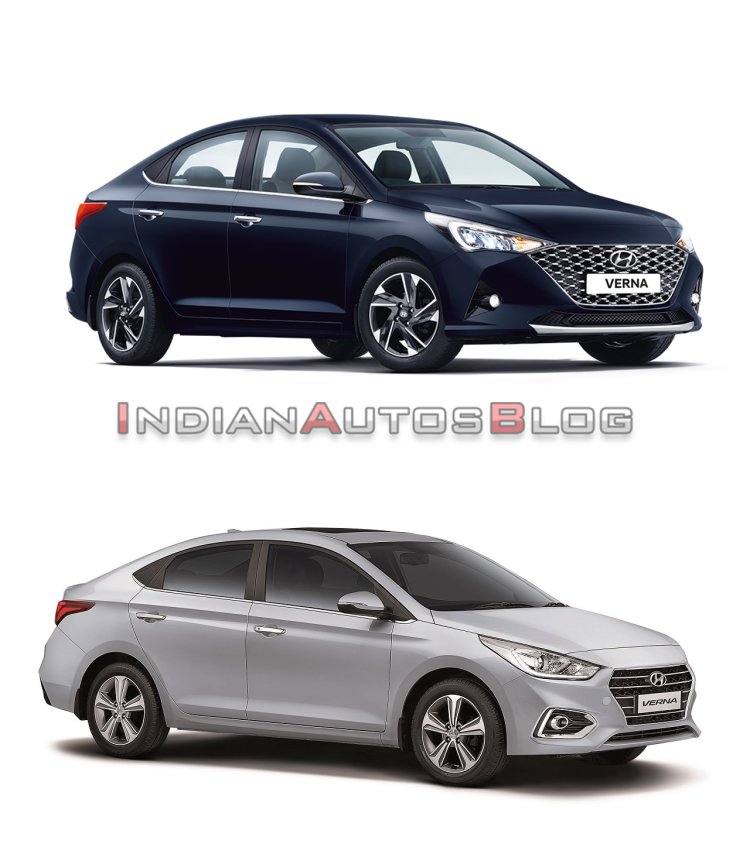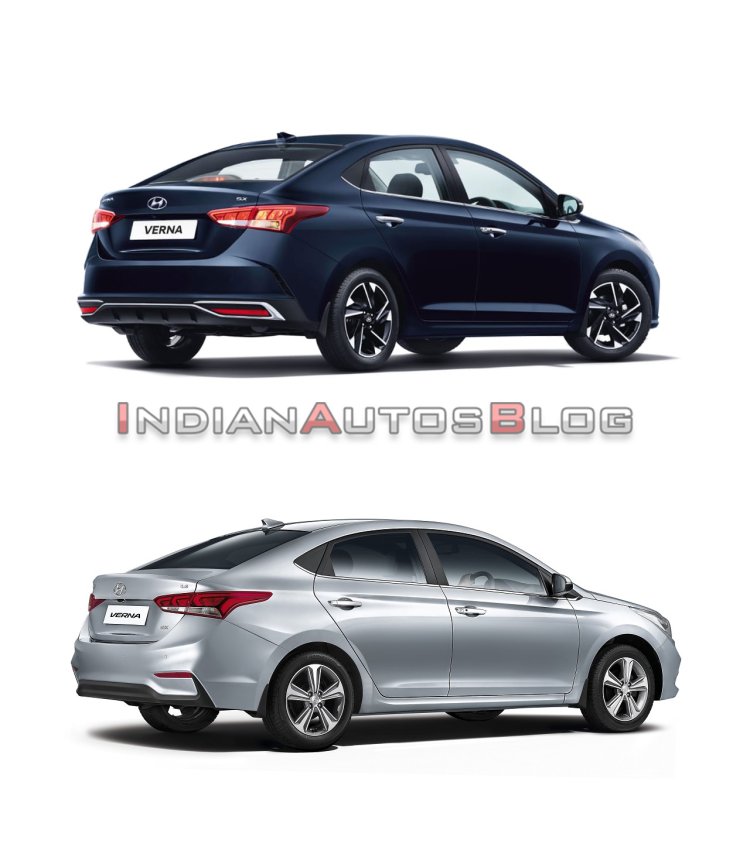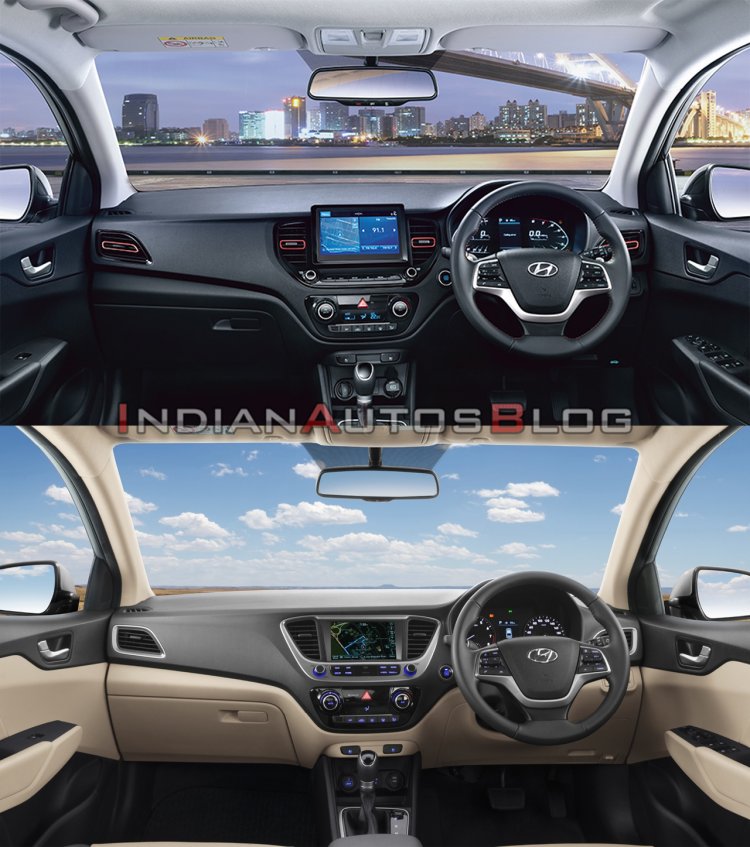2020 Hyundai Verna vs. 2017 Hyundai Verna - Old vs. New
When Hyundai came up with the fifth-gen Verna in 2017, it created new benchmarks in the segment when it came to design and engine performance. Now, it has given the sedan its mid-cycle refresh. Here's a detailed comparison between the 2020 Verna and 2017 Verna.
2020 Hyundai Verna vs. 2017 Hyundai Verna - Dimensions
Without much surprise, the new Hyundai Verna retains the original dimensions of the pre-facelift model. Given the fact that there is not much change in the original silhouette of the car, each and every dimension of the new Hyundai Verna has been kept unchanged.
| Dimensions | Hyundai Verna (new) | Hyundai Verna (old) |
| Length | 4,440 mm | 4,440 mm |
| Width | 1,729 mm | 1,729 mm |
| Height | 1,475 mm | 1,475 mm |
| Wheelbase | 2,600 mm | 2,600 mm |
2020 Hyundai Verna vs. 2017 Hyundai Verna - Design
Exterior design
When it comes to the design on the outside, Hyundai has nicely evolved the Verna. The new car looks sportier and at the same time more elegant as well.

At the front, the cascading grille with horizontal chrome slats has been replaced with a wider grille, which is there in two forms - dark chrome for the naturally aspirated petrol and diesel variants and glossy black for the turbocharged petrol variant. The halogen projector headlamps have been replaced with all-LED headlamps. The small projector fog lamps are now encased in triangular housings.

On the sides, there are new 16-inch machined alloy wheels. Changes at the rear include tail lamps with new LED inserts and a revised bumper with faux diffuser.
Interior design
The interior can now be had in a completely black theme with contrasting red stitching on seats, gear lever and steering wheel if specifying the car in the turbocharged petrol variant. There are a couple of feature revisions as well.

Firstly, the 7-inch touchscreen infotainment system has been replaced by an all-new tablet-like 8-inch unit. Also new is the inclusion of a fully digital instrument console with a 4.2-inch coloured MID.
2020 Hyundai Verna vs. 2017 Hyundai Verna - Features
The Mk5 Hyundai Verna was already a benchmark when it came to equipment, with several segment-first features like ventilated front seats and wireless charger. Now with the mid-life update, it has taken the game one level up with a few additional features. These include a fully digital instrument cluster, Bluelink telematics system, TPMS, remote climate control with AC start and remote engine start-stop.
2020 Hyundai Verna vs. 2017 Hyundai Verna - Engines & Transmissions
The 2017 Hyundai Verna already had the most versatile powertrain range in the segment, and the same goes for the new model. The old model used to be available with a choice of two petrol engines - a 1.4-litre petrol engine (99 PS/132 Nm) and a 1.6-litre petrol engine (123 PS/151 Nm) and two diesel engine options – a 1.4-litre unit (90 PS/220 Nm) and a 1.6-litre unit (128 PS/260 Nm). 5-speed manual, 6-speed manual and 6-speed automatic were the transmission choices.
The 2020 Hyundai Verna is available with three all-new engines – two petrol and one diesel. The petrol engines include a 1.5-litre naturally aspirated unit (115 PS/144 Nm) and a 1.0-litre turbocharged unit (120 PS/172 Nm). The diesel engine is a 1.5-litre turbocharged unit (115 PS/250 Nm). Instead of a 6-speed automatic transmission, there are CVT and 7-speed DCT options now. Unlike in the old model, there's no 5-speed MT option.
| Petrol engine | Hyundai Verna (new) | Hyundai Verna (old) |
| Engine type | 1.5-litre MPI/1.0-litre Kappa T-GDi | 1.4-litre VTVT/1.6-litre Gamma VTVT |
| Displacement | 1,497 cc/998 cc | 1,368 cc/1,591 cc |
| No. of cylinders | 4/3 | 4/4 |
| Power | 115 PS @ 6,300 rpm/120 PS @ 6,000 rpm | 99 PS @ 6,000 rpm/123 PS @ 6,400 rpm |
| Torque | 144 Nm @ 4,500 rpm/172 Nm @ 1,500-4,000 rpm | 132 Nm @ 4,000 rpm/151 Nm @ 4,850 rpm |
| Transmission | 6-speed manual or CVT/7-speed DCT | 5-speed manual/6-speed manual or 6-speed automatic |
| Drivetrain Layout | FWD | FWD |
| Diesel engine |
|
|
||
| Engine type | 1.5-litre U2 CRDi | 1.4-litre CRDI/1.6-litre U2 CRDi | ||
| Displacement | 1,493 cc | 1,396 cc/1,582 cc | ||
| No. of cylinders | 4 | 4/4 | ||
| Power | 115 PS @ 4,000 rpm | 90 PS @ 6,000 rpm/128 PS @ 4,000 rpm | ||
| Torque | 250 Nm @ 1,500-2,750 rpm | 220 Nm @ 1,500rpm/260 Nm @ 1,500-3,000 rpm | ||
| Drivetrain Layout | FWD | FWD |
2020 Hyundai Verna vs. 2017 Hyundai Verna - Fuel Efficiency
The 2017 Hyundai Verna was decently efficient. Below were its fuel economy ratings:
- 1.4-litre petrol-manual - 19.1 km/l
- 1.4-litre diesel-manual - 25.2 km/l
- 1.6-litre petrol-manual - 17.7 km/l
- 1.6-litre petrol-automatic - 15.92 km/l
- 1.6-litre diesel-manual - 24.75 km/l
- 1.6-litre diesel automatic - 21.02 km/l
The 2020 Hyundai Verna is overall more fuel-efficient. Below are its fuel economy ratings:
- 1.5-litre petrol-manual - 17.7 km/l
- 1.5-litre petrol-automatic - 18.45 km/l
- 1.0-litre petrol-automatic - 19.2 km/l
- 1.5-litre diesel-manual - 25.0 km/l
- 1.5-litre diesel-automatic - 21.3 km/l
2020 Hyundai Verna - Prices*
| Variant | Price |
| Verna 1.5 N/A petrol MT S | INR 9.31 lakh |
| Verna 1.5 N/A petrol MT SX | INR 10.70 lakh |
| Verna 1.5 N/A petrol MT SX(O) | INR 12.60 lakh |
| Verna 1.5 N/A petrol CVT SX | INR 11.95 lakh |
| Verna 1.5 N/A petrol CVT SX(O) | INR 13.85 lakh |
| Verna 1.0 turbo petrol DCT SX(O) | INR 13.99 lakh |
| Verna 1.5 turbo diesel MT S+ | INR 10.66 lakh |
| Verna 1.5 turbo diesel MT SX | INR 12.05 lakh |
| Verna 1.5 turbo diesel MT SX(O) | INR 13.95 lakh |
| Verna 1.5 turbo diesel AT SX | INR 13.20 lakh |
| Verna 1.5 turbo diesel AT SX(O) | INR 15.10 lakh |
Also Read: 2020 Hyundai Verna (facelift): Variant-wise changes explained
Stay tuned to IndianAutosBlog.com for more featured stories and the latest four-wheeler news.
*Ex-showroom India
You might also like
-

What Makes Modern Vehicles Smarter Than Ever Before
18/12/2025 - 21:31 -

6 Reasons to Hire a Lawyer for a Manufacturing Defect Accident Case
18/12/2025 - 12:58 -

BMW 3 Series Marks 50 Years and Prepares for All-Electric Next Generation
12/12/2025 - 15:11 -

Cold Weather Is Secretly Destroying Your Car Battery, Avoid These 5 Mistakes
11/12/2025 - 12:11




